The Big Read: Are public libraries dying? Not in Singapore - far from it
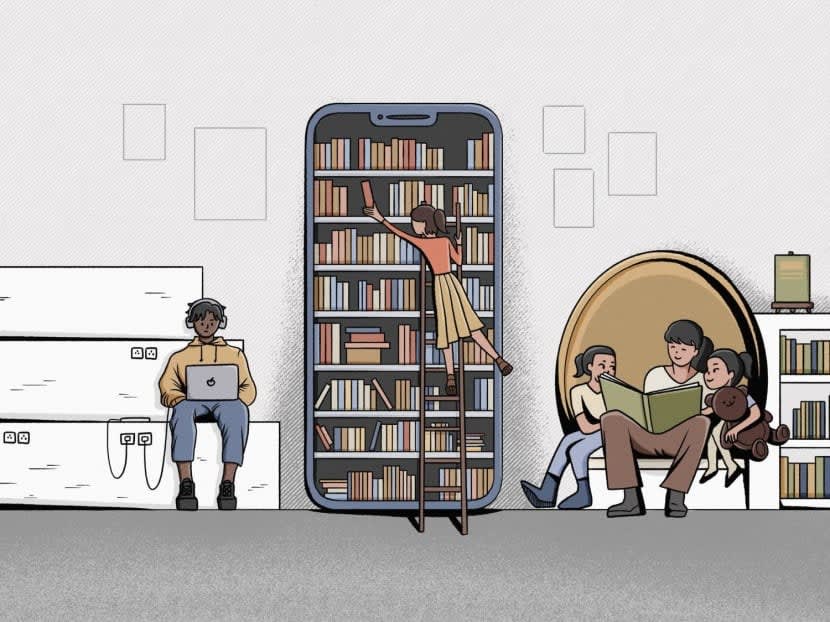
Apart from shifting their services online, libraries have also redesigned their physical spaces to go beyond being mainly repositories of books. (Photo: TODAY/Nurjannah Suhaimi)

This audio is generated by an AI tool.
- While public libraries in some countries are facing dwindling visitorship, funding cuts and copyright tussles amid the digitalisation wave, those in Singapore have escaped the same fate
- On the contrary, public libraries here are seeing increased number of visitors and plans are afoot to continuously rejuvenate and expand existing libraries; the five-storey Punggol Regional Library also opened its doors in April 2023
- According to users whom TODAY spoke to, libraries here have managed to adapt to their users' evolving needs
- Apart from shifting their services online, libraries have also redesigned their physical spaces to go beyond being mainly repositories of books
- Such moves - including opening a new Children's Biodiversity Library in January next year - are also seen as important to attract young users and cultivate a love for reading and learning
SINGAPORE: At the Queenstown Public Library, Mrs Diane Tan watched on as her 22-month-old daughter pulled book after book out of its mahogany shelves, flipping through the pages enthusiastically.
The unassuming two-storey establishment along Margaret Drive, with its pearl-grey exterior lined with bowtie motifs, is Singapore’s first-ever neighbourhood library and turns 53 in April next year.
The building might not appear to be a place a child would pine for, but on the rare days when it is closed - the library is open seven days a week except on public holidays - Mrs Tan said it is as if her daughter’s “favourite toy has been taken away”.
Even in a digital world where information is readily accessible at one’s fingertips at any given moment, the public library does not seem to have lost its relevance to Singaporeans both young and old.
Mr Marcus Loh, a 40-year-old who has been a frequent library goer for decades, said that its draw is as a space “deliberately designed” for one to read books comfortably.
“If you can spend two hours in a bookstore, then you can easily spend four hours in a library,” said Mr Loh, the director and head of strategic communication of digital transformation consultancy Temus.
Mr Loh’s habit of visiting public libraries has continued to this day despite his busy schedule and his acknowledgement that it would be easier to read on his smartphone. But he believes that the library is “a better search engine”, because he can access rare books no longer in print.
In addition to the National Archives of Singapore, the National Library Board (NLB) currently manages a network of 28 libraries - including the five-storey Punggol Regional Library, the newest library which opened in April this year.
Earlier this year, the library@esplanade closed its doors for good, with its collections and programmes to be moved to the National Library Building along Victoria Street, which houses the Central Public Library and the Lee Kong Chian Reference Library. The Central Public Library and Marine Parade Public Library are temporarily closed for renovations.
Nevertheless, the NLB also announced last month that the Bukit Batok Public Library will double in size as part of the board’s ongoing efforts to systematically rejuvenate existing libraries, with the Queenstown Public Library also slated for a revamp in the near future.
The NLB said in a media release on Nov 17 that as of August, 78 per cent of Singapore residents visited NLB’s libraries and archives and accessed its content in the preceding year.
This was up from 61.7 per cent in 2022, and 72.5 per cent in 2019 before COVID-19 struck.
In response to TODAY’s queries on public libraries' visitorship, the NLB said that it saw a total of 16.5 million visits in 2022 across its network of libraries, the National Archives of Singapore building at Canning Rise and the Former Ford Factory - an increase of 43.5 per cent, or 5 million, from 2021.
The Former Ford Factory along Upper Bukit Timah Road is managed by the National Archives of Singapore and houses a permanent World War II exhibition.

On whether the total space occupied by public libraries in Singapore has changed over the years, the NLB did not provide figures.
Still, the overall picture in Singapore stands in stark contrast to some other countries which are struggling to get citizens to visit their public libraries, resulting in a substantial number of closures.
According to the Chartered Institute of Public Finance and Accountancy in the United Kingdom, the number of in-person visits to libraries across England, Wales and Scotland dropped sharply from 335 million in 2005 to 215 million in 2020.
There, more than 780 libraries have been closed since 2010.
The situation in the United States paints a similarly gloomy picture. From 2010 to 2018, US public library building usage had fallen 31 per cent, based on a report in 2021 which analyses the performance and funding of public libraries in the US, the UK and Australia.
How have Singapore’s public libraries escaped the same fate?
In a nutshell, libraries here have managed to adapt to their users' evolving needs amid the digitalisation wave, according to users whom TODAY spoke to.
Mr Desmond Kon, who is an author and a senior lecturer of creative writing and publishing at Nanyang Technological University (NTU), noted how NLB has moved with the times, with its mobile application making it "really efficient" for users to search for books online and manage their book loans and renewals.
"As a writer, any dip into Singapore’s heritage has me heading to the National Library, which has made such precious, invaluable content readily available in digital form," he said.
CLOSURES, FUNDING CUTS, DWINDLING VISITORSHIP IN US AND UK
A Forbes article in 2012 written by a contributor painted a gloomy picture regarding the future of libraries and ended with the author’s prediction that library visiting would in “five to 15 years” become a thing of the past.
The crux of its argument is the idea that reading habits would shift primarily to the use of a digital tool - and once people get comfortable reading on smart devices, no one would see the point of going to the library.
A decade later, a 2021 national survey in the US found that only seven per cent of Americans visit libraries weekly, with six in 10 reporting they seldom or never visit their local public library.
There, libraries have also recently been embroiled in a slew of disputes pertaining to funding cuts, censorship and copyright issues.
In New York City, there are plans to close city libraries on Sundays and reduce city funding for libraries from US$36.2 million (S$48.5 million) a year to US$12.6 million in 2024.
Earlier this year, the US-based non-profit Internet Archive - which provides free universal access to books, movies and music - lost a lawsuit to four large corporate publishers which sued it for scanning and lending digital copies of copyrighted books without compensation or permission.
Singapore's National Library Board told TODAY that it has copyright policies in place that outline the use of copyrighted materials in its collections and services, and that it works closely with copyright owners and licensing agencies to obtain the necessary permissions and licenses.
While physical libraries still exist in the UK, the rise in digital information consumption habits (the global online audience typically accesses the internet for 6.21 hours daily) and the COVID-19 pandemic have led to an increase in e-book borrowing in the country, growing by 18 per cent from March 2020 to 2021.
Libraries in the UK have also been facing government funding cuts, with figures released by the UK's Chartered Institute of Public Finance and Accountancy indicating that in 2021/22, £9,982 (S$16,700) was spent per 1,000 people on libraries by central and local governments in England, Scotland and Wales, down from £12,646 in 2018/19.
ADJUSTING TO A DIGITAL-FIRST WORLD
The first and most obvious need pertains to a demand for convenient access to the library’s resources, driven by the increase in digital information consumption.
The NLB first started making e-books available for loan in 2005 to "address this growing preference and to provide convenience and easy access amid the busy lifestyles of working adults and youth".
Ms Vanessa Lee, 27, moved from Singapore to Australia for her studies two years ago. Before she moved Down Under, she had never stepped foot into a public library in Singapore as she preferred to buy her own books.
But since she left Singapore, the environmental science undergraduate who currently resides in Melbourne has been borrowing three to six e-books every month via the Libby app.
The app allows users all over the world to download e-books and audiobooks onto their devices from libraries which they are a member of, so they can read or listen to them without an internet connection.
“I like the feeling of having physical books, but now I prefer borrowing e-copies since it’s free and convenient. Apps like Libby have made reading much more accessible, all I need is a mobile phone,” Ms Lee said.
Similarly, when Mrs Tan, the mother with a 22-month-old daughter, finds herself having to soothe her weeping child in the middle of the night, Libby - not Google - is what she turns to for parenting advice, even if it takes a little more time.
“I think having Libby is very useful as a new parent when you’re looking for something credible, (because) everyone can claim to be an expert on the Internet,” the 33-year-old communications professional said.
“It's useful to be able to just read on my phone when everything else is very dark and you just want to keep the baby asleep.”
According to the NLB, the number of digital loans through the NLB mobile app and the Libby app grew by 500,000 to 13 million from 2021 to 2022. E-books account for one in three of its total loans.
Nevertheless, despite the rising popularity of e-books and audiobooks, the NLB said that they hope to deliver "an omni-channel experience" for the library's patrons as physical spaces "continue to be essential spaces for learning and reading".
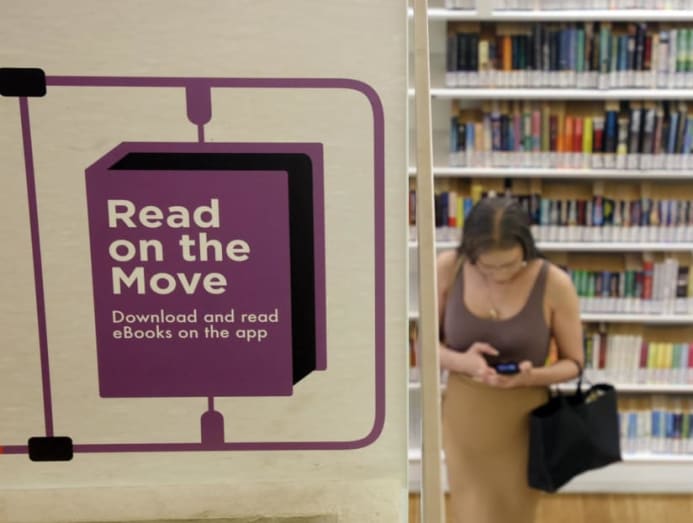
Library-goers agree, adding that the “magic” and other perks of being present in a physical library remain strong “pull” factors for those who visit frequently.
“I love browsing the shelves. It’s wonderful to stumble on a title or author unexpectedly - it’s the promise of a lovely surprise, almost a serendipity,” said Mr Kon, the NTU senior lecturer.
This element of unpredictability is what makes a library special, said 27-year-old entrepreneur Muhammad Firdaus Syazwani, who used to visit the library regularly as a polytechnic student. Since he started work, he visits the library less often.
“If I wanted to read something interesting but I didn't know what, I can just browse the different sections, read the synopsis or a few chapters. If I like it, I borrow it,” he said.
Mr Firdaus, whose professional expertise lies in search-engine optimisation (SEO), added that the internet might not be the best place to discover new authors and books that you like, because results on search engines can be “skewed”.
“Authors with marketing teams and titles frequently touted would come up more often. So even if there’s a book out there for you, if it isn't mentioned frequently, it’s not going to rank high on search,” he said.
Listen:
LIBRARIES' ROLE AND THEIR EVOLVING PHYSICAL SPACES
Around two decades ago, the value proposition of a library was that it provided people with the world’s information - fiction and otherwise - through the medium of books, said non-library goer Martin Layar, a management trainee in the shipping industry.
As digitalisation becomes part and parcel of daily life, the 26-year-old said he does not see the point in paying a visit to the library anymore.
But others told TODAY that public libraries' role has evolved beyond being mainly repositories of books.
Its physical spaces are also changing to meet another need - to help people engage with information on a deeper level, said Ms Shameem Nilofar Maideen, university librarian at the Singapore Management University (SMU).
In a similar vein, NLB’s director for planning and development Wan Wee Pin told CNA in August that the board does not want libraries to be places solely for reading anymore and its mission has evolved into one “of getting people to learn” - which can be through other means apart from reading.
Indeed, Singapore’s libraries of today look nothing like they did in decades past.
On the fourth floor of the new Punggol Regional Library for example, there is a dedicated space for library users to try their hand at fabrication technologies such as 3D printing and robotics, under an initiative called MakeIT at Libraries.
Just a few steps away is Launch, a business resource centre for aspiring entrepreneurs, microbusinesses and gig workers, complete with a meeting pod where patrons can consult with a start-up specialist during office hours.
If one were to take a brief walk around the rest of the Punggol library, the large walkways and spaces between aisles soon become apparent, so does the accessible nature of just about every facility.
There are wheelchair ramps to enter meeting booths, printing stations with high-contrast large-key keyboards and even private spaces known as “calm pods” for patrons to self-soothe.
According to NLB, these features were put in place to fulfil part of the role it sees itself playing as an “equaliser” to society, where everyone feels welcome within its spaces.
Libraries also have the potential to use their physical spaces to “open up” information and package them in different ways, to suit the learning style of different learners, said Ms Shameem, SMU's university librarian.
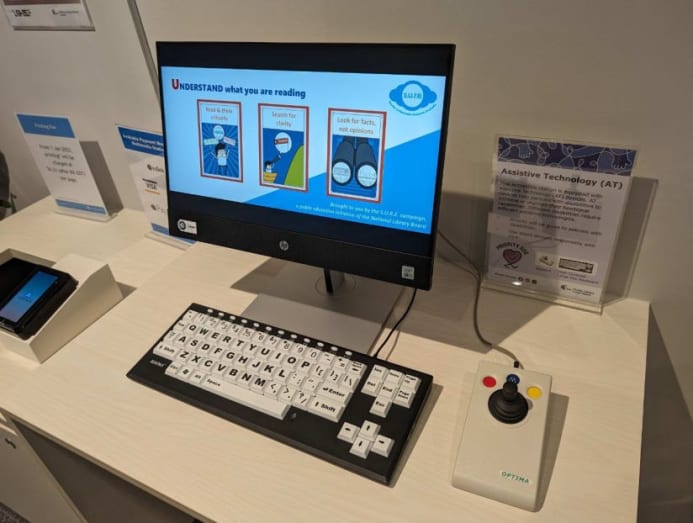
One such example is a new Children’s Biodiversity Library by SEA Aquarium that will be housed within the Central Public Library after it reopens on Jan 12 next year.
The children’s library will have an “Open Ocean Zone” featuring specimens such as shark jaws and coral skeletons, a floor-to-ceiling column with coral-like features and a video projection of a jellyfish habitat housed in the SEA Aquarium.
There will also be regular programmes for children to meet divers and aquarists, as well as opportunities to participate in intertidal animal art, storytelling and upcycling workshops.
It will be the first marine biodiversity-themed learning space for children at a public library in Singapore, aimed at enabling young patrons to explore the wonders of marine life through educational zones and programmes.
Mr Layar believes that such installations could attract young children and their families, including those who had not thought about visiting a library previously like himself.
“People have to be able to feel like making a trip to the library is worth their while; they need to gain something out of it.”
ENGAGING THE NEXT GENERATION
In May, the Progress in International Reading Literacy Study found that Singapore’s Primary 4 pupils topped global rankings in terms of reading literacy across all 57 countries and territories in the survey including Russia, the US and Ireland, which came in second.
In Singapore, the study surveyed more than 6,700 randomly selected Pri 4 students across 183 schools. However, it found that the proportion of these students who "enjoy reading a lot" fell to its lowest level in over a decade - falling to 51 per cent last year compared with 55 and 60 per cent in 2016 and 2011 respectively.
The NLB’s National Reading Habits Study 2021 showed a different picture when it comes to teenagers. In 2021, 85 per cent of younger teenagers (13 to 16 years old) and 86 per cent of older teenagers (17 to 19 years old) read for leisure more than once a week.
This was compared to 76 per cent and 83 per cent for younger and older teenagers respectively in 2018. In 2016, the corresponding proportions were 71 per cent and 72 per cent.
Initiatives such as the biodiversity library are important to build a relationship between children and public libraries, said frequent library goers.
They told TODAY that their childhood experiences at the library had played a role in shaping not just their reading habits of today, but also their disposition towards life.
Singaporean author Amanda Lee Koe said that she had “never lost that thrill of curiosity, openness and discovery of physically being in a library”, years after her parents took her and her siblings to the Marine Parade Public Library every weekend.
“We would lose ourselves for hours, roaming freely from shelf to shelf, genre to genre, filling up a big red basket with books, authors and worlds that we would otherwise not have encountered,” said Ms Lee Koe, 35.
Similarly, Ms Nicole Daduya, a 20-year-old undergraduate at SMU, said that libraries had enabled her to read more widely, eventually growing to like nonfiction and local literature as some of the more “popular” books that she did want to read were often on loan.
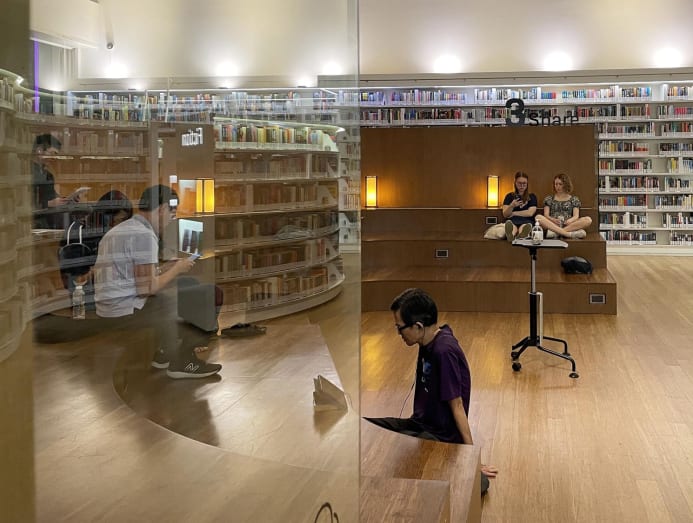
To cultivate a love for reading among young children, the NLB has ramped up the number of programmes for them in recent years.
It introduced the “Babies Can Be Members Too!” programme in 2016 to encourage bonding between parent and child through reading from an early age. Under the programme, parents can register their babies as library members and receive a gift pack comprising children’s books.
Then in 2020, the NLB launched “The Little Book Box”, a monthly subscription service in which eight curated books for children would be delivered to one’s home at a fee of S$10.80 a month. Since its launch in November 2020, the service has delivered more than 300,000 children’s books.
But perhaps its most ambitious and successful initiative geared towards children is “Book Bugs”, a bug-themed collectible card game to encourage reading in both English and Mother Tongue languages.
Children can borrow any library item or complete monthly quizzes to earn points, which can then be exchanged for collectible cards featuring unique bug characters - each with its own personality trait and lore inspired by books in Singapore’s national languages.
Since its inception in 2016, Book Bugs has been through four iterations, the latest of which in 2022 saw over 90,000 unique patrons redeem more than 2 million Book Bugs cards at public libraries. This contributed to over 10 million English and Mother Tongue book loans, the NLB said, adding that it would embark on its fifth iteration due to popular demand.
Listen:
LOOKING FORWARD
While many libraries overseas are struggling to survive, those interviewed by TODAY believe that the public libraries in Singapore would continue to have an important place in society - with advancements in technology helping the libraries to adapt to the new needs of users.
SMU's university librarian Ms Shameem said: “When you look at the conflicts of society today and in the future, it's not going to be determined purely by your military might … battles are being waged across digital screens.”
“That’s why being an information literate person who can critically engage with information on a deeper level is going to be a definite advantage in a complex world,” she said.
Beyond the public libraries, some academic libraries in Singapore have also made drastic changes to its operations to keep up with the times.
The Tay Eng Soon Library at the Singapore Institute of Management (SIM) last year became a “shelf-less” library to free up space for more collaborative purposes once occupied by shelves of physical books.
“The library is no longer just a space for self-study, it’s for discussion, for you to share knowledge,” said Mr Chuah Yeow Seng, SIM’s senior head of campus infrastructure and operations.
Its students may only pick out books they want via an app, after which its school librarians would collect and place them in designated collection points.
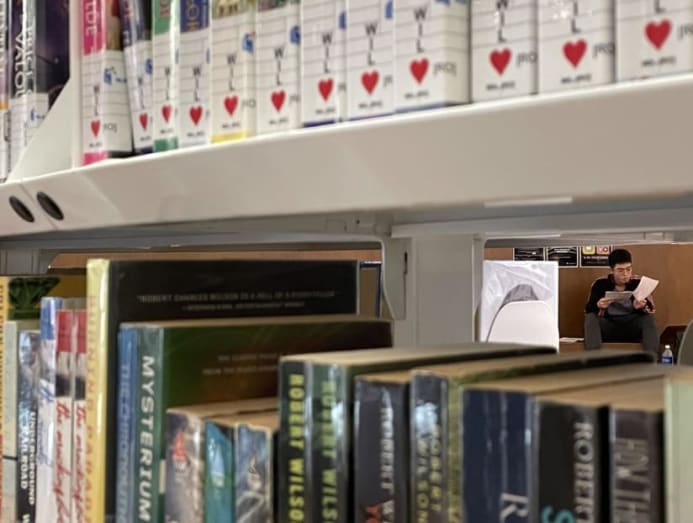
Libraries at SMU had also been intentionally designed with a substantial number of group study rooms to accommodate the shift from a “book-centred paradigm to an active-learning centred paradigm”, said Ms Shameem.
Within public libraries, the NLB has looked to digital technologies such as Augmented Reality (AR) to help bring stories and experiences to life. For example, there is an AR Learning Trail at the Choa Chu Kang Public Library.
"Libraries lower the barriers to entry for learning and we will continue extending this by providing patrons with opportunities to not only learn basic digital skills, but also emerging technologies such as Artificial Intelligence (AI)," the NLB said.
Last week, the NLB announced that it would pilot three tech prototypes, two of which would use generative AI. These are:
- ChatBook - A generative AI-powered chat service where users can have a conversation with books, by providing responses based on the content ingested. Through ChatBook, users can engage or even “debate” with books in an interactive manner and will also be prompted to either buy or borrow the books, or delve deeper into NLB’s online resources.
- Glue - A live visualiser that presents a dynamic composite of Singapore, past and present, through photographs, captions and bite-sized content from individuals and institutional sources.
- StoryGen - This provides an immersive experience that uses generative AI to transform stories in text form into a visual and multimedia experience. Users can exercise their creativity to present well-loved stories in their own ways.
Apart from these initiatives, the NLB will also continue to rejuvenate its existing public libraries.
For Mrs Tan and her daughter, who have made it a family “priority” to head to the library every other week to read, the familiar interior of Queenstown Public Library will soon look different following a scheduled closure for a revamp in early 2025.
The NLB said in July that the revamped Queenstown Public Library would incorporate wellness and sustainability features, with the library’s heritage weaved into its design and offerings.
While Mrs Tan felt that it would be a “much-deserved facelift”, she would miss it during its temporary closure. In the meantime, she and her daughter would relish the opportunity to venture to other libraries further out, while their neighbourhood library undergoes yet another evolution to change with the times.
This article was originally published in TODAY.










